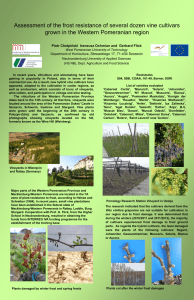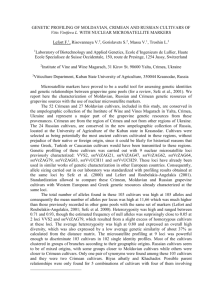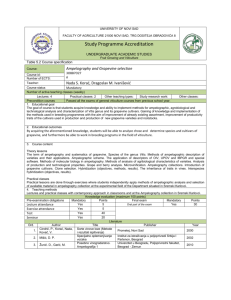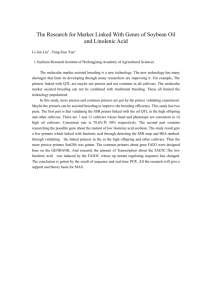Phenotypic Correlation between Some Nurserphelogical Traits
advertisement
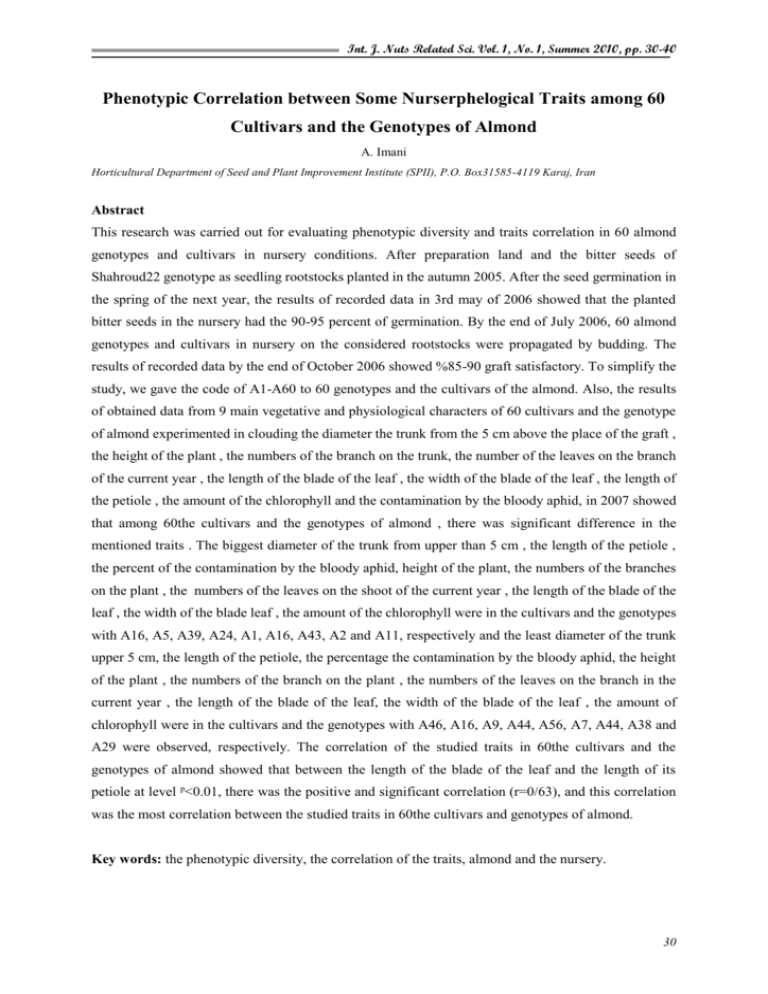
Int. J. Nuts Related Sci. Vol. 1, No. 1, Summer 2010, pp. 30-40 Phenotypic Correlation between Some Nurserphelogical Traits among 60 Cultivars and the Genotypes of Almond A. Imani Horticultural Department of Seed and Plant Improvement Institute (SPII), P.O. Box31585-4119 Karaj, Iran Abstract This research was carried out for evaluating phenotypic diversity and traits correlation in 60 almond genotypes and cultivars in nursery conditions. After preparation land and the bitter seeds of Shahroud22 genotype as seedling rootstocks planted in the autumn 2005. After the seed germination in the spring of the next year, the results of recorded data in 3rd may of 2006 showed that the planted bitter seeds in the nursery had the 90-95 percent of germination. By the end of July 2006, 60 almond genotypes and cultivars in nursery on the considered rootstocks were propagated by budding. The results of recorded data by the end of October 2006 showed %85-90 graft satisfactory. To simplify the study, we gave the code of A1-A60 to 60 genotypes and the cultivars of the almond. Also, the results of obtained data from 9 main vegetative and physiological characters of 60 cultivars and the genotype of almond experimented in clouding the diameter the trunk from the 5 cm above the place of the graft , the height of the plant , the numbers of the branch on the trunk, the number of the leaves on the branch of the current year , the length of the blade of the leaf , the width of the blade of the leaf , the length of the petiole , the amount of the chlorophyll and the contamination by the bloody aphid, in 2007 showed that among 60the cultivars and the genotypes of almond , there was significant difference in the mentioned traits . The biggest diameter of the trunk from upper than 5 cm , the length of the petiole , the percent of the contamination by the bloody aphid, height of the plant, the numbers of the branches on the plant , the numbers of the leaves on the shoot of the current year , the length of the blade of the leaf , the width of the blade leaf , the amount of the chlorophyll were in the cultivars and the genotypes with A16, A5, A39, A24, A1, A16, A43, A2 and A11, respectively and the least diameter of the trunk upper 5 cm, the length of the petiole, the percentage the contamination by the bloody aphid, the height of the plant , the numbers of the branch on the plant , the numbers of the leaves on the branch in the current year , the length of the blade of the leaf, the width of the blade of the leaf , the amount of chlorophyll were in the cultivars and the genotypes with A46, A16, A9, A44, A56, A7, A44, A38 and A29 were observed, respectively. The correlation of the studied traits in 60the cultivars and the genotypes of almond showed that between the length of the blade of the leaf and the length of its petiole at level p<0.01, there was the positive and significant correlation (r=0/63), and this correlation was the most correlation between the studied traits in 60the cultivars and genotypes of almond. Key words: the phenotypic diversity, the correlation of the traits, almond and the nursery. 30 Introduction (Barbera et al., 1994). The study of the reaction Iran is one of the most important centers of the of 24 cultivars of the self fertility almond in the plantation and the production of almond in the ecological condition of the South Eastern of world. In Iran, almond has the relatively good French have showed that among 24 cultivars, two benefits because of the suitable ecological cultivars of Steliette and Lauranne were selected conditions and its resistance to the drought and as the best self- compatible cultivars from the the calcareous conditions. Also, the trees of point of view of the habit of the growth, the late almond have the long age about 20-40 years, and flowering and the excellent performance (Duval they begin to bear fruit since 3-4 years old. So and Grasselly, 1994). besides the selection of the suitable place of the The study of the bioagronomical reaction of 22 orchard and its management, we must pay famous cultivars of the world in Italy showed that attention to select the suitable cultivar carefully. the late flowering cultivars have better efficiency The recognition and the evaluation of the in the years that there was late frost of the spring genotypes of almond can be base for the future and the index of the fertility was higher in the studies and for obtaining the desirable cultivars cultivars of the self compatible with the adverse or the cultivars having the special traits including conditions of the pollination (Viti and Loreti, habit of the desirable growth , the resistance to 1994). The study 30 superior genotypes and the coldness or the pest or the diseases (kester et cultivars in California showed that the cultivars al., seedling and the genotypes be have differently because of rootstocks and recognizing the cultivars have one the vegetative traits particularly the habit of the or some excellent traits and their usage in the growth (Ledbetter and Palmquist, 2002). The programs of the breeding and the cropping is evaluation of the biotic diversity of 88 cultivars very and the genotypes of almond in the collection of 1991).Obtaining important the (Kester suitable and Asay, 1975; Grasselly, 1986). the university of Bari in Italy showed that the Beside the recognizing and collecting the cultivars superior genotypes among the native population reproductive and vegetative traits have the (seedling orchards) of almond and also making different characteristics and these diversity new indices are very important hybrids , the evaluation and their and genotypes because of the comparison along with the important and in helping to choose of the breeder( De Giorgio commercial cultivars to obtain the cultivars with and Polignano, 2001).Lansary et al. (1994) could the desirable traits can make the great change in obtain the indices to distinguish the present the industry of almond .So ,the study of the cultivars and the present closes in the collections reaction of two cultivars of almond named of almond of California by the analysis of Ferragnes and Tuono along with 50 cultivars and multivarians genotypes in the ecological condition of the morphological parameters .The study of the South Italy showed that the phenological traits history of the search in Iran also shows that some and performance of cultivars have been different cultivars are better than other cultivars in the of the biochemical and the experimental conditions , so in the primary study studied in a similar environmental condition of of the native and foreign cultivars in the Station the nursery. For this, after providing of the field of Sahand after 14 years of studies revealed one and its preparation, the bitter seeds were planted native cultivar Sahand and 5 foreign cultivars ( in the autumn of 2005 in the nursery to produce Nonpareil , Ne Plus Ultra , Ferragnes, A 200 and the necessary seedling rootstocks. After the seed A230) and 2 hybrid ( Azar and Shokoufeh ) as germination in the spring of the next year, in 3rd the superior cultivars .Also study of some May of 2006, percent of germination of planted commercial Shahrekurd(Rabie, bitter seeds in the nursery was recorded. By the Mamaie and Sefid cultivars), shahrood (Shahrood end of July 2006, 60 almond genotypes and 12, 15, 16, 17, 18 and 21) and Karaj [(Genco, cultivars in nursery on the considered rootstocks Falsa Bares, Philip Ceo, Feragilo, Super nova and were propagated by budding. Percent of graft Tuono imported from Italy as the self compatible satisfactory recorded by the end of October 2006. cultivars and Marcona as self incompatible To simplify the study, we gave the code of A1- cultivar from Spain) and 35 superior selective A60 to 60 genotypes and the cultivars of the genotypes from almond breeding programs in almond (Table 5). Also, the results of obtained Karaj (specially resistant to the cold)] showed data from 9 main vegetative and physiological that some cultivars had performance better than characters of 60 cultivars and the genotypes of other cultivars((Imani et al, 2006). But up to almond experimented in clouding the diameter now, inside the country about the phenotypical the trunk from the 5 cm above the place of the behavior of these almond cultivars in a similar graft , the height of the plant , the numbers of the environmental condition of the nursery haven’t branch on the trunk , the number of the leaves on been performed, because in some of the cultivars the branch of the current year , the length of the of almond, they are used as the suitable seedling blade of the leaf , the width of the blade of the rootstock due to the habit of the vertical growth leaf , the length of the petiole , the amount of the and being the single trunk and good characters chlorophyll and the contamination by the bloody other. The aim of this study was to consider the aphid were recorded in 2007. In order to phenotypic behavior and the correlation of the evaluation of characteristics of 60genotypes and traits of 60 genotypes and the selective cultivars cultivars, 10 samples of plants were used for of almond in the similar conditions of nursery. every genotype and cultivar by3 replication. cultivars in The statistical analysis was performed using Materials and Methods Microsoft Excel (2007) and SPSS (14.0) The research works of this study were begun by Statistical Software. preparation and the plantation of the bitter seeds of Shahroud22 genotype as rootstock seedlings in Results and Discussion the autumn 2005. In this research for the The results of obtained data from 9 main phenotypic diversity, the number of 60 superior vegetative and physiological characters of 60 genotypes and the cultivars of the almond were cultivars and the genotypes of almond experimented in clouding the diameter the trunk chlorophyll , the contamination by the bloody from the 5 cm above the place of the graft , the aphid , the color of two end leaves and the color height of the plant , the numbers of the branch on of the tip of the branch were shown in tables 1, the plant ,the number of the leaves on the branch 2.3and 4. Also To simplify the study, we gave the of the current year , the length of the blade of the code of A1-A60 to 60 genotypes and the cultivars leaf , the width of the blade of the leaf , the of the almond (Table 5). length of the petiole , the amount of the Table.1 Analysis variance of deferent traits in 60almond genotypes and cultivars The source of Degree of the freedom variance Genotype 59 Error 120 Coefficient of the variances The numbers of the leaves on the shoot of the current year 183.5422 3.47778 Mean Square Width of the The length of the blade leaf blade of the leaf 3.2302 4.8618 0.3215 1.2518 0.2922 Length of the petiole 1.2518 0.2922 7.2210 22.0943 13.1627 Bloody aphid 48.6915 0.0000 0 Mean Square The source of the variance Degree of freedom Genotype Error Chlorophyll Diameter of the trunk Height of the plant The numbers of the branches on the plant 59 47.3160 0.1838 35370.324 566.9476 120 0.0000 0.0328 0.0328 2.5944 Coefficient of the variances 13.2931 13.8007 3.230 8.2335 As it was shown in Table 1, there was a In Table 2, the comparison of the average of the significant difference between genotypes and the different traits in 60 cultivars and the selective cultivars of the almond according to the studied genotype traits in the ecological conditions of the nursery. of almond was presented. Table.2 Mean comparison of traits in 60almond genotypes and cultivars trait 2.11 Height of the plant Mean 135.333a 130.000b 126.333c 120.000d 120.000d 115.667de 110.333ef 109.667ef 107.667efg 106.333 efgh 106.333efgh 106.333efgh 105.775efghi 105.667efghi 105.123efghi 104.000fghij 103.333ghijk 102.000ghijkl 102.000hgijkl 101.333hgijklm 101.000hgijklm 101.000hgijklm 100.667hijklm 100.000hijklm 98.667ijklmn 97.667jklmno 97.667jklmno 95.333jklmnop 95.333jklmnop 94.667klmnopq 94.333klmnopq 94.333lmnopq 93.667mnopq 93.000nopqr 92.667nopqr 92.000opqr 92.000opqr 91.667opqr 91.667opqr 91.333opqr 90.667pqrs 90.000opqrst 90.000qrstu 90.000qrstu 90.000rstu 89.000stuv 89.000tuv 88.667uvw 88.333uvw 88.000uvw 87.333vwx 87.333vwx 86.667vwxyz 86.000wxyz 85.333xyz 85.000yz 85.000yz 84.000yz 79.333z 75.000z var A24 A40 A16 A43 A17 A32 A30 A13 A41 A15 A4 A20 A49 A21 A60 A52 A7 A35 A2 A42 A51 25 A54 A6 A28 A29 A3 A55 A31 A5 A11 A18 A47 A14 A9 A19 A36 A50 A53 A1 A34 A26 A23 A58 A38 A10 A59 A37 A45 A12 A46 A57 A22 A39 A56 A8 A48 A33 A27 A44 2.5 Width of the blade leaf(cm) 2.6The length of the blade of the leaf (cm) Mean Mean 6.0333 a 3.4667b 3.4000bc 3.3333bcd 3.1000 bcd 3.0333 bcdef 3.0333 bcdef 3.0000 bcdefg 2.9333 bcdefgh 2.9000 bcdefgh 2.8333 bcdefghi 2.8333 bcdefghi 2.8000 bcdefghij 2.7667 bcdefghij 2.7667 bcdefghijk 2.7000 bcdefghijk 2.7000 bcdefghijk 2.6000 bcdefghijk 2.5000 bcdefghijk 2.5000 bcdefghijk 2.4667 bcdefghijk 2.4333 bcdefghijk 2.4333 bcdefghijk 2.4333 bcdefghijk 2.4000 bcdefghijk 2.3667 bcdefghijk 2.3667 bcdefghijk 2.3667 bcdefghijk 2.3667 bcdefghijk 2.3333 cdefghijk 2.3333cdefghijk 2.3000cdefghijk 2.3000cdefghijk 2.2667 defghijk 2.2667 defghijk 2.2333 defghijk 2.2000 efghijk 2.1667 efghijk 2.1667 efghijk 2.1000 efghijk 2.1000 efghijk 2.0667 efghijk 2.0667 efghijk 2.0667 efghijk 2.0333 efghijk 2.0333 efghijk 2.0333 efghijk 2.0000 efghijk 2.0000 efghijk 1.9667 fghijk 1.9333 fghijk 1.9000ghijk 1.9000 ghijk 1.9000 ghijk 1.8667hijk 1.8333 hijk 1.7667ijk 1.7000ijk 1.6667k 1.6667k var A2 A3 A4 A7 A9 A33 A54 A43 A24 A30 A45 A58 A5 A36 A52 A10 A37 A40 A60 A15 A46 A42 A22 A14 A48 A53 A19 A49 A6 A35 A51 A32 A21 A20 A25 A1 A11 A56 A12 A59 A23 A57 A39 A18 A27 A29 A44 A31 A23 A34 A17 A26 A16 A55 A13 A47 A50 A8 A28 A38 10.8333a 10.2667ab 10.1667abc 10.0000abcd 9.9333abcde 9.8667abcde 9.4333 bcdefg 9.2000 acdefgh 9.2000 acdefgh 9.1667 cdefgh 9.1667 cdefgh 9.0000 defghij 8.9333 defghij 8.9333 defghij 8.8667 efghij 8.8333 fghij 8.6667ghijk 8.6000 ghijkl 8.6000 ghijkl 8.5000 ghijkl 8.4333 ghijklm 8.3333 ghijklmn 8.3333 ghijklmn 8.1667hijklmno 8.1000 ghijklmnop 8.1000 hijklmnop 8.0667 hijklmnop 8.0333 ijklmnop 7.9333 jklmnopq 7.9333 klmnopq 7.5667 klmnopqr 7.5000 lmnopqr 7.5000 lmnopqr 7.5000 lmnopqr 7.5000 lmnopqr 7.5000 lmnopqr 7.3333lmnopqrs 7.3333 mnopqrs 7.3333 mnopqrs 7.3000 mnopqrs 7.2333 nopqrs 7.1667opqrst 7.0000 pqrst 6.9000pqrstu 6.8333 pqrsu 6.8333 pqrstu 6.8000 pqrstu 6.8000 qrstu 6.7667rstu 6.7667rstu 6.7333rstu 6.6667rstu 6.5000rstuv 6.4333 rstuv 6.3333stuv 6.3333 stuv 6.0667tuv 5.8333vu 5.6000v 4.5000w var A43 A4 A41 A3 A4 A5 A54 A45 A45 A40 A14 A2 A32 A10 A33 A6 A36 A42 A21 A37 A35 A9 A18 A12 A46 A19 A20 A25 A39 A38 A23 A15 A48 A24 A53 A58 A1 A49 A47 A16 A27 A30 A26 A55 A17 A34 A11 A8 A51 A29 A31 A22 A52 A59 A60 A50 A56 A57 A28 A44 2.7 The numbers of the leaves on the shoot of the current year Mean var 75.000 a 74.667a 68.000b 64.000c 63.333c 62.000c 62.000c 62.000c 58.000d 57.000de 7.000de 56.333def 56.333 def 5.667defg 55.333defgh 55.000 defghi 55.000 defghi 54.333 defghij 54.000 defghij 54.000 defghij 53.667 efghij 53.333 fghij 53.000 fghij 53.000 fghij 53.000 fghij 53.000 fghij 52.667 fghij 52.667 fghij 2.667 fghij 52.333 ghij 52.333 ghij .333 ghij 52.333 ghij 51.667 hij 51.667 hij 51.333 ij 51.333 ij 51.000 jk 48.000 lk 47.333 lk 47.333 lk 47.000mnl 47.000 mnl 46.000 mnlo 45.667 mnop 45.000 mnlopq 45.000 mnlopq 44.333 mnopqr 44.000 mnopqr 43.667 nopqr 43.000 opqr 43.000 opqr 42.667 opqr 42.333pqr 42.333pqr 42.000qr 42.000 qr 2.000 qr 41.000r 37.333s A16 A40 A50 A21 A28 A26 A55 A18 A17 A2 A20 A31 A3 A49 A23 A53 A8 A30 A60 A15 A13 A11 A32 A43 A35 A51 A4 A9 A25 A34 A54 A38 A39 A29 A47 A42 A52 A41 A14 A19 A1 A48 A5 A37 A59 A24 A46 A10 A57 A44 A12 A45 A56 A36 A6 A58 A22 A27 A33 A7 Con.Table.2 Mean comparison of traits in 60almond genotypes and cultivars 2.10 The numbers of the branches on the plant Mean var 31.67a A1 25.00 b A16 19.67c A28 17.67bcd A50 16.67bcde A11 15.00bcdef A18 15.00 bcdef A20 15.00 bcdef A32 14.67 bcdef A17 14.25 bcdef A29 14.11 bcdef A55 14.00 bcdef A31 13.67 bcdef A12 13.00 bcdef A40 13.00 bcdef A26 13.00 bcdef A36 12.56 cdef A19 12.41 cdef A8 12.11 cdef A13 12.11 cdef A9 12.11 cdef A23 12.11 cdef A7 12.11 cdef A48 12.00 cdef A49 11.67 cdef A22 11.00 cdef A53 10.33 cdef A21 10.00 cdef A52 10.00 cdef A14 10.00 cdef A60 9.67 cdef A51 9.33 cdef A6 9.00 cdef A34 9.00 cde A4 9.00 cdef A42 9.00 cdef A5 9.00 cdef A3 8.33 cdef A41 8.33 cdef A15 8.00 def A58 8.00 def A59 8.00 def A27 8.00 def A57 8.00 def A54 8.00 def A33 7.33 def A30 7.00 def A45 7.00 def A24 7.00 def A47 7.00 def A35 700 def A38 6.00 ef A10 5.00 ef A44 5.00 ef A2 5.00 ef A39 5.00 ef A43 4.00 ef A37 4.00 ef A25 3.67 ef A46 3.67 ef A56 2.1 f chlorophyll level Mean 27.367a 24.600ab 23.433bc 23.133bc 22.933 bc 19.933dc 19.133de 18.733def 18.600def 18.433def 18.300defg 17.700 defgh 17.500 defghi 17.100 defghij 16.867 defghijk 16.733 defghijk 16.567 defghijk 16.100 defghijkl 16.067 defghijkl 15.967 efghijklm 15.867 efghijklm 15.867 efghijklm 15.800 efghijklm 15.767 efghijklm 15.733 efghijklm 15.667 efghijklm 15.567 efghijklm 15.567 efghijklm 15.533 efghijklm 15.500 efghijklm 15.133 efghijklm 14.933 fghijklmn 14.900 fghijklmn 14.733 fghijklmno 14.300 ghijklmnop 14.100 hijklmnopq 13.800 hijklmnopqr 13.433 ijklmnopqr 13.267jklmnopqrs 12.867 klmnopqrs 12.833klmnopqrs 12.467 lmnopqrst 12.433 lmnopqrst 12.333lmnopqrst 12.200 lmnopqrst 12.167 lmnopqrst 12.067lmnopqrst 12.033 lmnopqrst 11.900 mnopqrst 11.100 nopqrst 10.767opqrst 10.667 pqrstu 10.567 pqrstu 10.233 qrstu 10.100 qrstu 9.933 rstu 9.300stu 8.800tu 8.533tu 7.13U var A11 A7 A6 A59 A54 A1 A10 A23 A44 A15 A3 A20 A16 A2 A39 A27 A17 A47 A37 A60 A4 A12 A49 A14 A29 A50 A8 A51 A26 A34 A13 A40 A43 A48 A9 A30 A5 A21 A18 A33 A42 A36 A46 A57 A52 A22 A31 A25 A38 A53 A55 A19 A41 A35 A28 A58 A56 A45 A32 A29 traits 2.2 The numbers aphid on plant Mean var 21.00a A39 14.00b A15 12.00c A12 11.00d A23 11.00d A17 11.00d A34 11.00d A24 10.00e A11 9.00f A14 9.00f A21 9.00f A40 9.00f A16 8.00g A13 8.00g A20 8.00g A35 7.00h A43 7.00h A41 7.00h A31 6.00i A25 6.00i A32 6.00i A19 6.00i A33 5.00j A10 5.00j A38 5.00j A22 5.00j A18 5.00j A48 5.00j A36 5.00j A42 5.00j A7 5.00j A29 5.00j A50 4.00k A3 4.00k A46 4.00k A49 3.00l A37 3.00l A53 3.00l A45 3.00l A8 3.00l A27 3.00l A60 3.00l A54 3.00l A58 2.00m A44 2.00m A28 2.00m A30 2.00m A51 2.00m A2 2.00m A59 2.00m A52 2.00m A56 2.00m A6 1.00n A5 1.00n A47 0.00o A57 0.00o A26 0.00o A1 0.00o A4 0.00o A55 0.00o A9 2.3 Diameter of the trunk (cm) mean 2.3000a 2.0333ab 1.8000bc 1.7667bcd 1.6867bcd 1.6100cdef 1.5667 cdefg 1.5333 cdefgh 1.5033 cdefghi 1.5000 cdefghi 1.4633 cdefghij 1.4600 cdefghij 1.4533 cdefghij 1.4400 defghijk 1.4000 efghijkl 1.3767 efghijkml 1.3700 efghijkml 1.3667 efghijkml 1.3500 efghijklmn 1.3467 efghijklmn 1.3333 efghijklmn 1.3333 efghijklmn 1.3233 fghijklmn 1.3200 fghijklmn 1.3100 fghijklmn 1.3033 fghijklmn 1.3000 fghijklmn 1.3000 fghijklmn 1.2933 fghijklmn 1.2900 fghijklmn 1.2700 fghijklmn 1.2667 fghijklmn 1.2667 fghijklmn 1.2667 fghijklmn 1.2667 fghijklmn 1.2333 ghijklmn 1.2300 ghijklmn 1.2167 ghijklmno 1.2067 ghijklmno 1.2067 ghijklno 1.2033 ghijklno 1.2000 ghijklmno 1.2000 ghijklmno 1.2000 ghijklno 1.1767 hijklmno 1.1667 hijklmno 1.1667 hijklmno 1.1367 ijklmno 1.1333 ijklmno 1.1333 ijklmno 1.1333hijklmno 1.1000 jklmno 1.1000jklmno 1.0967jklmno 1.0667 klmno 1.0567lmno 1.0133mno 1.0122no 1.0033o 1.0000o var A16 A2 A18 A9 A32 A60 A8 A10 A58 A4 A56 A41 A52 A59 A20 A50 A38 A12 A55 A54 A5 A29 A53 A36 A40 A57 A24 A43 A33 A31 A48 A3 A13 A17 A14 A7 A35 A51 A30 A45 A6 A19 A49 A21 A47 A11 A1 A34 A22 A27 A23 A26 A15 A44 A25 A37 A42 A28 A39 A46 2.4 Length of the petiole(mm) Mean 2.6333a 2.4333a 2.2667bc 2.1667bcd 2.1667bcd 2.0667ecde 2.0667 cde 2.0667 cde 2.0333f cde 2.0000 fcdeg 1.9667 cefdeg 1.9000 cefdegh 1.8667defgih 1.8000 defgijh 1.7667 degfijkh 1.7667degfijkh 1.7333 degijkh 1.7000 egfijghkm 1.6667 ehgfijgklmn 1.6333hgfijgklmno 1.6333h gfijgklmno 1.6333hgfijgklmno 1.6333hgfijgklmno 1.6333hfijgklmno 1.6000hfijgklmno 1.5333hijklmnoqp 1.5333hijklmnoqp 1.5000hijklmnoqpr 1.4667 ijklmnoqprs 1.4667 ijklmnoqprs 1.4667 ijklmnoqprs 1.4333 jklmnoqprs 1.4333 jklmnoqprs 1.4333jklmnoqprs 1.4333 jklmnoqprs 1.4000 jklmnoqprst 1.4000 jklmnoqprst 1.3667 klmnoqprst 1.3667 klmnoqprst 1.3667 klmnoqprst 1.3333lmnoqprst 1.3333lmnoqprst 1.3333 lmnoqprst 1.3000 mnoqprst 1.3000mnoqprst 1.2667noqprst 1.2667noqprst 1.2667 noqprst 1.2333 oqprst 1.2333oqprst 1.2333oqprst 1.2000 qprst 1.1667 qrst 1.1667 qrst 1.1333 qrst 1.1000 st 1.0667 st 1.0000t 1.0000t 1.0000t var A5 A54 A43 A33 A36 A35 A4 A25 A2 A41 A3 A19 A7 A45 A42 A15 A18 A28 A6 A40 A37 A48 A8 A9 A52 A16 A53 A39 A13 A20 A12 A55 A32 A30 A10 A22 A38 A29 A31 A21 A60 A1 A27 A51 A23 A11 A49 A56 A14 A47 A34 A46 A24 A17 A57 A26 A59 A44 A50 A16 As it was shown in Table2, the biggest diameter The studied traits in 60 cultivars and the selective of the trunk from upper than 5 cm , the length of genotypes of almond base on the minimum, the petiole , the percent of the contamination by maximum, the deviation of the standard, the the bloody aphid, height of the plant, the numbers mean, and their index of diversity has bean of the branches on the plant , the numbers of the presented in Table 4. leaves on the shoot of the current year , the length of the blade of the leaf , the width of the blade leaf , the amount of the chlorophyll were in the cultivars and the genotypes with A16, A5, A39, A24, A1, A16, A43, A2 and A11, respectively and the least diameter of the trunk upper 5 cm, the length of the petiole, the percentage the contamination by the bloody aphid, the height of the plant , the numbers of the branch on the plant , the numbers of the leaves on the branch in the current year , the length of the blade of the leaf, the width of the blade of the leaf , the amount of chlorophyll were in the cultivars and the genotypes with A46, A16, A9, A44, A56, A7, A44, A38 and A29 were observed, respectively. The results of the correlation of the studied traits in 60 cultivars and genotypes of almond have been shown in Table3 that between the length of the blade of the leaf and the length of its petiole at level p<0.01, there was the positive and significant correlation (r=0/63), and this correlation was the most correlation between the studied traits in 60 the cultivar and genotype of almond. Also the correlation of between the length of the leaf and its width of the leaf was positive (%49.15) that showed important leaf and its area in increasing assimilation in fruit, because of most almonds with larger leaves have bigger fruits (Kester and Gradziel, 1996; Ledbetter and Palmquist, 2002; De Giorgio and Polignano, 2004). Table 3 The traits correlation among studied 60almond genotypes and cultivars in nursery condition The length of the Trait The diameter of the plant ( cm ) The diameter of the plant ( cm ) 1.00000 The height of the plant ( cm) 0.03517ns The height of the plant ( cm) The numbers of the branch on the plant The numbers of the leaves on the current year branch The length of the blade of the leaf ( cm ) The width of the blade of the leaf ( cm ) petiole ( cm ) The amount of chlorophyll The numbers of the bloody aphids 1.00000 The numbers of the branch on the the plant 0.15680* -0.01938 ns 1.00000 The numbers of the leaves on the current year branch 0.24632** -0.01047 ns 0.25747** 1.00000 The length of the blade of the leaf ( cm ) 0.11000 ns -0.06225 ns -0.15427* -0.06225 ns 1.00000 The width of the blade of the leaf ( cm ) 0.25500** 0.10418* -0.17927* -0.12789 ns 0.49152** 1.00000 0.13680 ns -0.07787 ns -0.14359* -0.07787 ns 0.63844** 0.41464** 1.00000 The amount of chlorophyll -0.03916 ns -0.05348 ns 0.07557 ns -0.02776 ns 0.04252 ns 0.07547 ns -0.08756 ns The numbers of the bloody aphids -0.15101* 0.21785** -0.02867 ns 0.15390* 0.11151 * -0.13708 ns -0.05813 ns The length of the petiole ( cm ) 1.00000 0.10442* **: significant (at level p<0.01); * significant (at level p<0.05); ns: no significant 34 1.00000 Table.4 Minimum, maximum, standard deviation, mean, diversity index of traits in 60almond genotypes and cultivars Dependent variable Diameter of the trunk (cm) The height of the plant ( cm) The numbers of the branch on the plant The numbers of the branches on the plant Length of the petiole(mm) The width of the blade of the leaf ( cm ) The length of the petiole (mm ) Number of observations 180 180 chlorophyll level The numbers of aphid on plan Mean 2.60 166.00 Standard deviation 0.28 13.02 1.31 97.22 Diversity index (%) 21.37 13.39 0 51.00 14.29 18.29 78.13 180 35.00 76.00 7.92 51.83 15.78 180 3.50 11.20 1.34 7.85 17.07 180 1.50 4.20 0.78 2.44 31.96 180 0.80 3.00 0.39 1.56 25 180 180 6.50 0. 00 29.50 21.00 4.27 4.00 15.10 5.20 28.27 76.92 Minimum Maximum 0.81 62.00 180 As in table 4 has been shown, the highest Anyway, these diversity indexes can help to and lowest deviation of standard were the breeder selection in areas of heredity studies numbers of the branch on the plant (14.29) and molecular markers. and diameter of the trunk (0.28). In table (1994),using morphological variation within 4, diversity index can be important to help collections of Moroccan almond clones and the breeder selection. The highest and Mediterranean and North American cultivars; lowest diversity index relate to the Kodak numbers of the branch on the plant phenotypic (%78.13) and diameter of the trunk agrochemical traits of the almond kernel and (%21.37). Daneshvar and Sardabi (2006) variation of These results concord with other results flowering period among 60 almond genotypes from phenotypic diversity investigation of obtained the indexes for distinguishing of almond in almond cultivars and genotypes. The results of California (Ledbetter and Palmquist , present research obtained indexes and different 2002), bio diversity of 80 almond cultivars habitats of growth in various almond cultivars in Italy (De Giorgio and Polignano, 2004). and genotypes in nursery conditions cultivars and genotypes Lansari, et al., and Socias i company (2005) correlation between some Table.5 Codes of 60almond genotypes and cultivars code A1 A2 A3 A4 A5 A6 A7 A8 A9 A10 A11 A12 A13 A14 A15 A16 A17 A18 A19 A20 Var./geno. K-6-8 K-4-6 K-5-27 K-2-34 K-4-14 K-1-21 K-1-32 D-101 K-16-25 K-8-4 K-13-1 K-16-8 K-15-5 K-14-7 K-8 K-13-22 K-16-23 K-11-9 K-13-40 K-9-7 code A21 A22 A23 A24 A25 A26 A27 A28 A29 A30 A31 A32 A33 A34 A35 A36 A37 A38 A39 A40 Var./geno. Shahrood13 K-14-a4 K-11-10 K-16-30 Shahrood16 Shahrood21 K-10-2 باال9 8-a34 Shahrood8 K-9-2 K-9-24 Shahrood15 K-9-20 K-11-8 K-10-14 K-10-16 K-9-36-32 Shahrood12 K-9-37 code A41 A42 A43 A44 A45 A46 A47 A48 A49 A50 A51 A52 A53 A54 A55 A56 A57 A58 A59 A60 Var./geno. K7-17 K-10-11 Flipe Ceo K-5-13-2 K-4-7 Falsa Bares Genco Fragilo tuono Marcona Supernova Mamaie Rabie Sifid Azar Nonpareil Sahand A-230 Shekofeh A-200 References Barbera, G., Martini, L. & Monastra, F. (1994) Response of Ferragnes and Tuono almond cultivars to different environmental conditions in southern Italy. Acta Horticulturea, 373: 99-103. Daneshvar, H. A. & Sardabi, H. (2006) Variation of flowering period among 60 almond genotypes. Acta Horticulturea, 726: 273-278. De Giorgio, D., Polignano, G. B. (2001) Evaluating the biodiversity of almond cultivars ... Symposium on Olive Growing, 27 September–2 October 2004. Izmir, Turkey Duval, H., Grasselly, C. (1994) Behaviour of some sel-fertile almondselection in the south east of France. Acta Horticulture, 373: 95-98. Grasselly, C. (1986) Recent advences an breeding potentialy of almond species, application to the french climatic situation in CR.Acad, Agric.fr.724. pp. 343-352. Imani, A., Hassani, D. & Rahemi, A. (2006) Following almond footprints in Iran. In: Avanzato D. & Vassallo I. (Eds.). Following almond footprints (Amygdalus communis) cultivation and culture, folk and history traditions and uses. ISHS. Scripta Horticulturae, 4: 71-79. Kester, D. E. & Asay, R. A. (1975) Almond breeding, pp. 382-719. Inj Janick and J.N.Moore (Eds) Advances in fruit breeding.purdue university press. west lafa yette IN. Kester, D. E., Gradizl, T. M. & Grasselly, C. (1991) Almond. Acta Horticulturae, N.290. Kester, D. E., Gradziel, T. M. (1996) Almonds. In: Janick J. & Moore J. N. Fruit breeding. Vol. III: Nuts: 1-97. John Wiley & Sons, New York (USA). Kodak, O., Socias i company, R. (2005) Phenotypic correlation between some agrochemical traits of the almond kernel. Acta Horticulturea, 726. Lansari, A., Iezzoni, A. F. & kester, D. E. (1994) Morphological variation within collections of Moroccan almond clones and Mediterranean and North American cultivars. Euphitica, 78: 27-41. Ledbetter, C. A., Palmquist, D. E. (2002) Evaluation of advanced almond (Prunus amygdalus Batsch) selection relative to the commercial almond cultivars Mission, Nonpareil and Padre II. Vegetative and carpological characteristics. Journal of Genetic and Breeding, 56: 37-41. Palasciano, M., Godini, A. (2001). Garibaldina, an additional Promising selfcompatible Apulian almond variety. Options Mediterraneennes, series Ghiers, 59: 329-331. Socias I company, R. (1992). Breeding Selffertile almonds . Pant Breeding Reviews, 8: 313-38. Viti, R., Loreti, F. (1994) Research on the bioagronomic behaviour of 22 almond cultivars of various origins. Acta Horticulturae, 373: 65-71.


